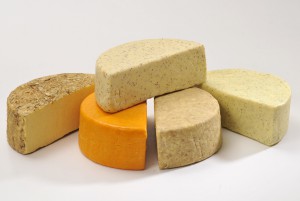13th March 2014 Warsaw, Poland
Say Cheese – Say Cheshire
Say Cheese – We’ve been all the way to Chester to taste some Cheshire
Piesek P is on the lookout for GREAT British Cheese in Poland – as he finds it he’ll let you know – just smile,
Cheshire Cheese is thought to be Britain’s oldest named cheese. It was originally the generic name for cheese produced in the county of Cheshire and parts of surrounding counties. The first cheese is believed to have been produced in Cheshire, by the Romans, in the garrison town of Chester. Cheshire Cheese is mentioned in the Domesday Book at the end of 11th Century.
Cheshire Cheese was traded across the country. The different varieties of Cheshire Cheese were aged to a sufficient level of hardness to withstand the rigours of transport (by horse and cart, and later by boat) to London for trading purposes. This trade started in the early 17th Century. From 1739, Cheshire Cheese was the only cheese bought for consumption by the British Navy.
During the 19th century, sales of Cheshire Cheese grew strongly as it became a firm favourite in the industrial towns and cities of the midlands and north of England. Cheshire Cheese was a cheap form of protein and was sometimes referred to as the poor man’s meat. As the towns grew, milk produced on nearby farms was used for liquid consumption and the main Cheshire Cheese producing areas spread further out, to the south of Chester and towards the Shropshire borders. Cheshire Cheese remains the UK’s largest selling crumbly cheese with sales of around 6,000 tonnes per year.

Despite the introduction of modern technology, the cheese making process is still similar to that used centuries ago. Whole cows milk is collected daily from farms, tested for quality, pasteurised then piped into large vats. To make the milk sour, special cultures called ‘starters’ are added to the vat. Once soured, vegetarian Rennet, which contains enzymes, is added to cause the milk to separate into curds and whey. The curds are stirred and turned on special cheese tables making it easier to drain away the whey. The curds are then salted by hand using local Cheshire salt. They are then milled into small pieces, put into moulds and wrapped in cheese cloth to help drain excess whey from the curd. They are then placed in large presses. After pressing the cheese has a crumbly texture. It is taken out of the moulds and the cheese cloth is removed. The cheese is vacuum packed in special bags, traditionally bound or waxed and then placed in store to mature for a matter of weeks or months depending on the maturity required. Expert graders check the cheese throughout the maturation process.
Dense and crumbly, Cheshire is made using vegetarian rennet and pasteurized cow’s milk. The taste and flavor of cheese develops with ripening. Young Cheshire is firm, crumbly and white in color. It is mild, milky and aromatic leaving behind a slightly tangy aftertaste on the palette. Sometimes, to add a different dimension to the cheese, annatto is added to the milk, which gives Red Cheshire a deep shade of red orange. However, there is no difference in the flavor and texture in both cousins. Another variant is a Blue Cheshire ripened with Penicillium culture molds. The cheese is then sealed with cloth or other wrapping material and at about 5 weeks of age the cheese is pierced with stainless steel needles to allow air to enter the body of the cheeses. This activates the blue mould which then proceeds to break down the protein in the cheese and create the blue veins. An aged Cheshire becomes more firm and darkens considerably. It is now a full-flavored cheese yet with no hint of bitterness. Though still crumbly, the cheese turns dry with maturity.
Cheshire with its lower salt content makes for a perfect crumble on fruits, chutney, and vegetable and baked dishes. In spring crumble and melt it over a favourite meat dish – local lamb; in summer it is GREAT crumbled over green leaves, in Autumn over a vegetable bake. For a winter dinner try it melted over chick peas with pepper bake. Young Cheshire likes to be eaten with a young crisp wine. More mature deserves a medium bodied red.
Say Cheese – Say Caerphilly – A fine cheese from Wales – Taste some for yourself today